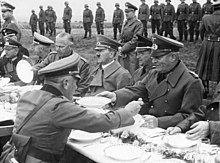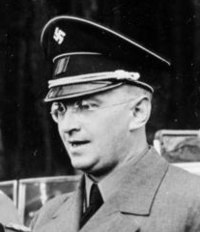Konrad Henlein

Konrad Ernst Eduard Henlein (born May 6, 1898 in Maffersdorf , Kingdom of Bohemia ; † May 10, 1945 in Pilsen , Czechoslovakia ) was a Sudeten German National Socialist politician and SS-Obergruppenführer . After becoming a full-time gymnastics teacher for the largest club in the German Gymnastics Association in Czechoslovakia in Asch in 1925 , he transformed the association into a political movement. In 1931 he took over the management of the general association and in 1933 founded the Sudeten German Home Front with the participation of various right-wing parties , later the Sudeten German Party (SdP), as a collection movement of the German gymnasts and the successor party to the National Socialist DNSAP . While the SdP celebrated great electoral successes under his leadership, Henlein established close contacts with the NSDAP and, in consultation with Adolf Hitler, pushed the Sudeten crisis in 1938 . With the incorporation of the Sudetenland into the German Reich , Henlein officiated as Gauleiter and Reich Governor in the new Sudetengau from October 1938 . Notwithstanding a promotion to SS-Obergruppenführer in 1943, he did not emerge politically until 1945.
Life
Origin and youth
Konrad Henlein was born to Catholic parents, the accountant Konrad Henlein sen. and his wife Hedwig, who was the daughter of a Czech and a German-Bohemian. When Henlein applied for membership in the National Socialist German Workers' Party on January 26, 1939 , however, he stated that his mother's ethnicity was "German ethnicity" and that her maiden name was "Dworatschek". But it was not until April 18, 1941 that the Czech form of the mother's maiden name, Hedwig Anna Augusta Dvořáček, was officially changed to the name "Dworaschek".
Henlein attended the commercial academy in Gablonz and trained as a bank clerk . In the spring of 1916 he joined the Austro-Hungarian army and took part in the First World War. He fought in the mountain war on the Italian front, where he was taken prisoner on November 18, 1917 . During the imprisonment, which he spent in a camp on the island of Asinara off Sardinia , he dealt intensively with the ideas of the German gymnastics movement . After his return in 1919 he worked as a bank clerk in Gablonz and initially worked as a volunteer in the German national gymnastics movement . In 1925 he finally took over a position as a gymnastics teacher in Asch . There he married the gymnast and pastry chef Emma Geyer in 1926, with whom he later had 5 children. After Konrad Henlein became leader of the Sudeten German Gymnastics Federation in 1931, he tried to develop the gymnastics movement as a political force.
Going into politics
On October 1, 1933, Henlein founded the "Sudeten German Home Front" (SHF) in Eger . DNSAP and the German National Party had recently disbanded to forestall a ban by the Czechoslovak government. Many former functionaries and politicians from these parties took part in the founding of the new movement. The SHF quickly found a broad base among the Germans in Bohemia , although by the mid-1930s the Social Democratic and Communist parties had more supporters.
Henlein initially expressed himself in his speeches in terms of an activist policy ; he emphasized his loyalty to the Czechoslovak state, within which he wanted to strengthen the co-determination and self-administration rights of the German minority . It is still controversial among historians to what extent this was a matter of conviction or - as Henlein later claimed - of tactical behavior.
On April 19, 1935, the SHF was renamed the Sudeten German Party (SdP). This was systematically expanded in the following years with massive support from the NSDAP . In the 1935 elections, the SdP won 44 of the 66 German seats in the Prague parliament. From November 21, 1936 to January 31, 1939 Henlein was chairman of the Association of German Nationalities in Europe . In November 1937, Henlein submitted a letter to Hitler's expansionist policy - possibly after agents from Berlin had instigated a revolt against him in the SdP. From this point on, the goal was undisguised to join the Sudeten areas with the National Socialist German Reich .
Between September 12 and 13, 1938, Henlein launched the “First September Uprising”, an attempt at a coup d'état in the border districts. This rebellion was quickly stifled by the Czechoslovak army and police. The SdP, which was still in talks with the government on September 11, was banned. The entire SdP leadership fled to Germany, where Henlein initiated the formation of the " Sudeten German Freikorps ", of which he became the commander. This “Sudeten German Freikorps” was organizationally assigned to the SS-Totenkopfverband under Theodor Eicke and incorporated by them at the end of 1938.
On September 21, 1938, the "Second September Uprising" took place in the Asch district (the westernmost border district of the republic). Because the Czechoslovak government feared a provocation by Hitler with the aim of dragging the Czechoslovak side into acts of war, the police and military behaved passively. By September 23, the SdP guerrillas managed to rule the entire Asch district. On September 30, the Munich Agreement was signed , to which the Czechoslovak government capitulated. The next day the German Wehrmacht occupied around a third of the Czech part of the country. According to the Munich Agreement, Henlein was Reichskommissar for the Sudeten German territories from the beginning of October 1938 and became Gauleiter of the Sudetengau on October 30, 1938 . On October 9, 1938, he was authorized to wear the uniform of an SS group leader ; he was now SS honorary leader and politically subordinate to the "Staff RFSS ". In January 1939 he applied for membership in the NSDAP and received membership number 6,600,001. A little later he also actively joined the SS (SS No. 310.307) and was promoted to SS-Obergruppenführer on June 21, 1943 .
After the supplementary election on December 4, 1938 to the Reichstag elected in April 1938, Henlein came as a member of the National Socialist Reichstag for the Sudetenland , to which he was a member until the end of Nazi rule in spring 1945.
National Socialism
After the rump Czech state was occupied by German troops, he was briefly head of the civil administration of Bohemia and Moravia from March 16, 1939 . At the beginning of May 1939, after the reorganization of the Reichsgau Sudetenland, he was appointed Reich Governor and remained in this position, as well as Gauleiter, until the end of the war . From mid-November 1942 to May 1945 he was also Reich Defense Commissioner .
During the Second World War he hardly appeared politically. Of Heydrich , head of the Reich Security Main Office , he was reportedly found to be unreliable. However, a replacement failed because of Henlein's close relationship with Hitler. Apparently Henlein was largely disempowered, worked for a time as a British spy and maintained contacts with Wilhelm Canaris .
Henlein committed on May 10, 1945 in American captivity suicide .
literature
- Ralf Gebel: “Heim ins Reich!” Konrad Henlein and the Reichsgau Sudetenland 1938–1945 (= publications of the Collegium Carolinum. Volume 83). 2nd Edition. Oldenbourg, Munich 2000, ISBN 3-486-56468-4 ( urn : nbn: de: bvb: 12-bsb00092896-5 ).
- Hermann Graml : Henlein, Konrad. In: New German Biography (NDB). Volume 8, Duncker & Humblot, Berlin 1969, ISBN 3-428-00189-3 , pp. 532-534 ( digitized version ).
Web links
- Literature by and about Konrad Henlein in the catalog of the German National Library
- Newspaper article about Konrad Henlein in the 20th century press kit of the ZBW - Leibniz Information Center for Economics .
- Konrad Henlein: The German cultural tasks in Czechoslovakia (speech of February 26, 1936 in the German House, Prague).
- Manfred Wichmann: Konrad Henlein. Tabular curriculum vitae in the LeMO ( DHM and HdG )
- Konrad Henlein and the Henlein legend on bohemistik.de (PDF; 1.4 MB) with contemporary caricatures.
Individual evidence
- ↑ a b Ralf Gebel: “Heim ins Reich!” Konrad Henlein and the Reichsgau Sudetenland (1938–1945). 2nd Edition. Oldenbourg, Munich 2000, p. 43 .
- ^ Nazi apologetic: Karl Höffkes : Hitler's political generals. The Gauleiter of the Third Reich. 2nd Edition. Grabert Verlag, Tübingen 1997, ISBN 3-87847-163-7 , pp. 139-141.
- ↑ Baptismal register Maffersdorf 1890–1900, fol. 231.
- ↑ a b c Heinz Höhne : “Kohen” cannot be grasped - two studies about Konrad Henlein - spy of the British and Gauleiter of the Sudetenland . In: Die Welt , August 21, 1999
- ↑ Dan Diner (Ed.): Encyclopedia of Jewish History and Culture (EJGK). Volume 2: Co-Ha. Metzler, Stuttgart / Weimar 2012, ISBN 978-3-476-02502-9 , p. 289.
- ↑ a b Joachim Lilla: The representation of the "Reichsgau Sudetenland" and the "Protectorate of Bohemia and Moravia" in the Grossdeutsche Reichstag . In: Bohemia. Journal of History and Culture of the Bohemian Lands , Volume 40, Issue 2, 1999, p. 458
- ↑ Janus: The Papers of Group Captain Malcolm Christie.
| personal data | |
|---|---|
| SURNAME | Henlein, Konrad |
| ALTERNATIVE NAMES | Henlein, Konrad Ernst Eduard (full name) |
| BRIEF DESCRIPTION | Sudeten German National Socialist politician and SS-Obergruppenführer |
| DATE OF BIRTH | May 6, 1898 |
| PLACE OF BIRTH | Maffersdorf , Kingdom of Bohemia |
| DATE OF DEATH | May 10, 1945 |
| Place of death | Pilsen , Czechoslovakia |

